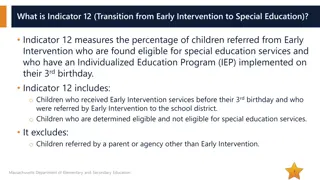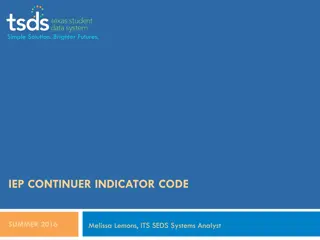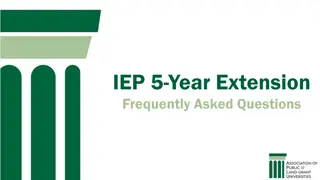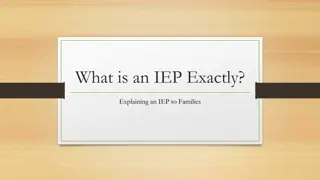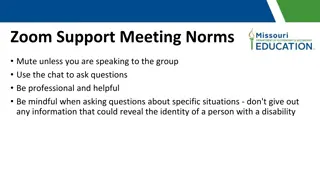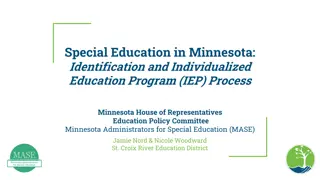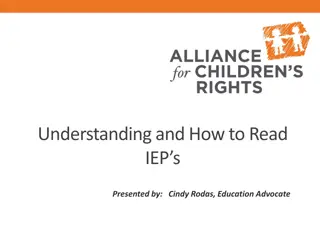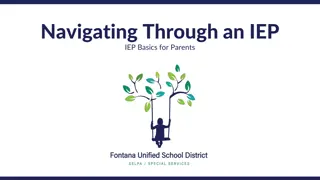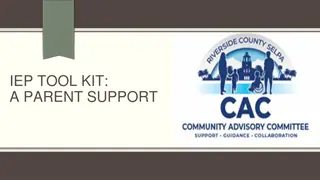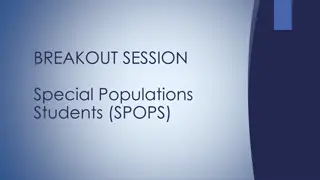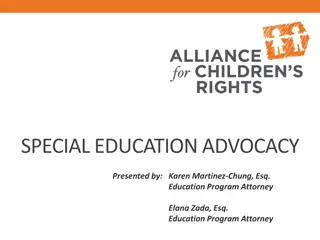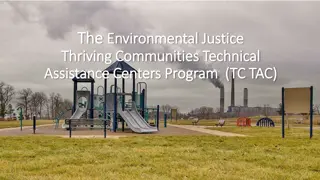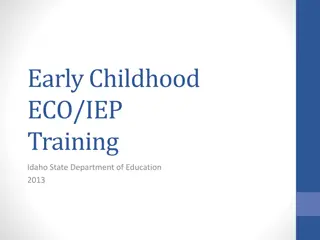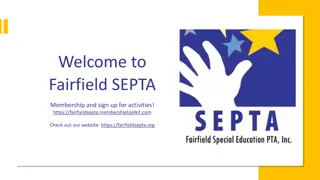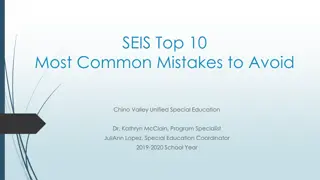Evaluation & IEP Technical Assistance Module - Special Education Overview
This module provides guidance on evaluations, IEPs, and special education for individuals with disabilities under IDEA 2004 and WAC 392-172A. It covers components, evaluations, reevaluations, prior written notice, consent, specially designed instruction, present levels, measurable annual goals, IEP summary, LRE explanation, secondary transition, postsecondary goals, and transition services.
Download Presentation

Please find below an Image/Link to download the presentation.
The content on the website is provided AS IS for your information and personal use only. It may not be sold, licensed, or shared on other websites without obtaining consent from the author.If you encounter any issues during the download, it is possible that the publisher has removed the file from their server.
You are allowed to download the files provided on this website for personal or commercial use, subject to the condition that they are used lawfully. All files are the property of their respective owners.
The content on the website is provided AS IS for your information and personal use only. It may not be sold, licensed, or shared on other websites without obtaining consent from the author.
E N D
Presentation Transcript
Evaluation & IEP Technical Assistance Module (IDEA 2004 and WAC 392-172A) OSPI SPECIAL EDUCATION OLYMPIA, WASHINGTON APRIL 2008 (REVISED AND UPDATED DECEMBER 2017)
Disclaimer The information contained in this module is meant to supplement and not supplant reading bulletins and accompanying documents; guidance from the U.S. Department of Education; chapter 392-172A WAC; Part 300 of the federal regulations; and the Individuals with Disabilities Act. This module should be viewed and applied by users according to their specific needs. The module should be used as guidance and is not intended as legal advice. 2
Table of Contents Overview . . . . . . . . . . . . . . . . . . . . . . . . . . . . Slide 6 Components . . . . . . . . . . . . . . . . . . . . . . . . . Slides 7-10 Two Years of Data . . . . . . . . . . . . . . . . . . . . . Slides 11-13 Evaluations and Reevaluations . . . . . . . . . . Slides 14-24 Prior Written Notice & Consent . . . . . . . . . . . . . . . Slides 14-15 Scope/Content . . . . . . . . . . . . . . . . . . . . . . . . . . . . . Slides 16-21 Students with Specific Learning Disabilities . . . . . Slides 18-21 Evaluation and IEP Consistency . . . . . . . . . . . . . . Slide 22 When Reevaluations are Needed. . . . . . . . . . . . . Slides 23-24 Specially Designed Instruction . . . . . . . . . . . Slides 25-30 Present Levels . . . . . . . . . . . . . . . . . . . . . . . . Slides 31-36 3
Table of Contents (continued) Measurable Annual Goals . . . . . . . . . . . . . . Slides 37-70 Overview and Quick Check . . . . . . . . . . . . . . . . . Slides 37-39 Reading . . . . . . . . . . . . . . . . . . . . . . . . . . . . . . . . . . Slide 40-42 Writing . . . . . . . . . . . . . . . . . . . . . . . . . . . . . . . . . . . Slide 43-45 Math . . . . . . . . . . . . . . . . . . . . . . . . . . . . . . . . . . . . Slide 46-48 Behavior/Social . . . . . . . . . . . . . . . . . . . . . . . . . . . Slides 49-54 Adaptive/Life Skills . . . . . . . . . . . . . . . . . . . . . . . . . Slide 55-57 Study Skills/Organization . . . . . . . . . . . . . . . . . . . . Slide 58-60 Speech/Language. . . . . . . . . . . . . . . . . . . . . . . . . . Slide 61-63 Fine/Gross Motor . . . . . . . . . . . . . . . . . . . . . . . . . Transition/Vocational . . . . . . . . . . . . . . . . . . . . . . . Slide 67-70 Slide 64-66 IEP Summary of Services . . . . . . . . . . . . . . . . Slides 71-72 LRE Explanation . . . . . . . . . . . . . . . . . . . . . . . Slides 73-75 4
Table of Contents (continued) Secondary Transition . . . . . . . . . . . . . . . . . Transition Assessment . . . . . . . . . . . . . . . . . . . Slides 77-79 Measurable Postsecondary Goals . . . . . . . . . . . Slides 80-94 Education/Training Goals . . . . . . . . . . . . . . . . . . . . Slides 83-85 Employment Goals . . . . . . . . . . . . . . . . . . . . . . . . Slides 86-88 Independent Living Goals . . . . . . . . . . . . . . . . . . . Slides 89-92 Transition Services . . . . . . . . . . . . . . . . . . . . . . . . Slides 93-97 Course(s) of Study . . . . . . . . . . . . . . . . . . . . . . . . Slides 98-101 Annual IEP Goals . . . . . . . . . . . . . . . . . . . . . . . . . Slides 102-103 Student Participation . . . . . . . . . . . . . . . . . . . . . . Slide 104 Transition Agency Participation . . . . . . . . . . . . . Slide 105 Secondary Transition Resources . . . . . . . . . . . Slide 106 Additional Resources . . . . . . . . . . . . . . . . . Contact Information . . . . . . . . . . . . . . . . . . Slide 108 Slides 76-106 Slide 107 5
Overview This training module is designed to provide information and guidance related to several major areas under IDEA 2004 and WAC 392-172A. The areas included in this module are those that, based on program review (monitoring) results, continue to present the greatest challenges to special education professionals in our state. 6
Module Components Module Overview and Instructions for Use Power Point with presenter notes including a review of the WACs related to each topic and practical guidance on implementation, including compliant and non-compliant examples in many of the areas. 7
Module Components (continued) Eight sample Evaluations and IEPs collected through monitoring reviews conducted during the 2012-13 school year that demonstrate non-compliance in one or more of the identified areas. Analysis of Samples Descriptions of the compliant and non- compliant elements identified in each of the eight samples provided. A Module Index, by specific topic, for cross referencing the power point and the samples to assist with easy access of information. Evaluation and IEP review forms that could be used by staff when reviewing evaluations, reevaluations, and IEPs for compliance. 8
Compliance Rates % of Compliant Files in the Identified Areas 98.3% 98.6% 100% 97.8% 97.7% 94.2% 93.1% 90% 80% 76.4% 75.9% 2015-16 2016-17 70% 60% 50% Sufficient Evaluations Consistency SDI Secondary Transition 11
Compliance Rates (continued) % of Compliant Files in the Identified Areas 100% 98.7% 99.2% 99.5% 98.6% 96.9% 96.7% 96.2% 95.9% 92.0% 92.3% 90% 86.6% 80.1% 80% 2015-16 70.1% 2016-17 70% 60.0% 60% 50% LRE Measurable Goals Progress Reports State IEP Team Summary of Services Present Levels Explanation Assessment 12
This module will focus primarily on those areas that present the greatest challenges to our state in meeting requirements under the provisions of IDEA: oMeasurable annual goals oSecondary transition The module will also briefly address other areas, including evaluation sufficiency, evaluation and IEP consistency, the provision of specially designed instruction and related services, present levels, IEP summary of services, and LRE explanation, but these will not be a major focus. 13
Evaluations and Reevaluations Prior Written Notice (WAC 392-172A-05010) Prior written notice must be provided to the parent a reasonable time before the district proposes to initiate an evaluation of a student. The notice must include: An explanation of why the district has decided to conduct the evaluation; A description of the evaluation procedures, assessments, records, or reports that will be used; What other options the district may have considered in the evaluation process and why those options were accepted or rejected; and A description of any other factors the district considers to be relevant to the decision to evaluate the child. Prior written notice must be provided in the parent s native language or other mode of communication used by the parent. 14
Evaluations and Reevaluations - Consent WAC 392-172A-03000 Written parental consent is required before conducting an initial evaluation or when conducting additional assessments as part of a reevaluation. If the parent refuses consent for the initial evaluation or reevaluation, the district may pursue an evaluation through mediation or due process. The district may proceed with a reevaluation if the parent fails to respond to the district s request for consent. Note: Districts may not pursue mediation or due process to override a parent s refusal to consent to initial services. 15
Evaluations and Reevaluations WAC 392-172A-01035(1) and -03035 Evaluations and Reevaluations must document eligibility, including: o The presence of a disability in one of the identified disability categories; o the adverse educational impact of that disability; and o the student s need for specially designed instruction. Must also provide information that will assist the IEP team in developing the IEP, including information regarding the student s ability to be involved and progress in general education curriculum. 16 See also Evaluation samples A, G, and H.
Evaluations and Reevaluations WAC 392-172A-03020 through -03040 Evaluations and Reevaluations must also: use information from multiple sources (rather than relying on a single measure or assessment); be administered so as not to be discriminatory on a racial or cultural basis; assess the student in all areas related to the suspected disability; rule out the lack of appropriate instruction in reading & math and limited English proficiency as determinant factors; and contain the date and signature of each professional member of the evaluation group. 17 See also Evaluation sample E.
Students with SLD WAC 392-172A-03045 through -03080 Evaluations for students suspected of having a specific learning disability must also: include additional required evaluation group members; document lack of achievement in at least one of eight areas; rule out additional determinant factors; and include the results of an observation of the student. 18 See also Evaluation samples A, B, and G.
SLD Severe Discrepancy WAC 392-172A-03065 and -03070 If the district uses the severe discrepancy methodology for SLD eligibility: Evaluation must establish a severe discrepancy between the student s intellectual ability and academic achievement in one or more of the eight areas; or document the use of professional judgment, including a written narrative, to justify the presence of SLD. http://www.k12.wa.us/SpecialEd/pubdocs/SLD_Guide.pdf 19 See also Evaluation samples A and B.
SLD Response to Scientific Research-Based Intervention WAC 392-172A-03060 If the district uses a process based on the student s response to scientific research-based intervention for SLD eligibility, the evaluation must: include evidence of the student s opportunity to increase rate of learning; document two or more intensive, scientifically research- based interventions implemented with fidelity; describe instructional strategies used and data collected; and include documentation of parent notification. 20
SLD Pattern of Strengths and Weaknesses WAC 392-172A-03080 The student s pattern of strengths and weaknesses in performance, achievement, or both, relative to age, state grade level standards or intellectual development may be used as part of the eligibility determination when using either of the SLD methodologies - severe discrepancy or response to research-based intervention. However, the pattern of strengths and weaknesses is not a standalone methodology for determining eligibility under the category of SLD. 21
Evaluation and IEP Consistency WAC 392-172A-03035 and -03110 The evaluation report must include the recommended special education and related services needed by the student and other information needed to develop an IEP . The IEP team must consider the results of the initial or most recent evaluation of the student . The IEP team revises the IEP, as appropriate, to address the results of any reevaluations . 22 See also Evaluation & IEP sample C.
When Reevaluations are Needed WAC 392-172A-03015 and -03025 -03015 = a reevaluation must be conducted when the district determines that the educational and related services needs, including improved academic achievement and functional performance, of the student warrant a reevaluation. -03025 = a reevaluation must determine whether the student continues to meet eligibility, and whether any additions or modifications to the special education and related services are needed to enable the student to meet the measurable annual goals set out in the IEP. 23
When Reevaluations are Needed (cont.) WAC 392-172A-03030 A reevaluation should be conducted prior to making significant changes in the student s program/services (i.e. placement). A reevaluation is necessary prior to determining that a student is no longer eligible for special education services. A reevaluation is not necessary before a student graduates from high school with a regular diploma or exceeds age eligibility. 24
Specially Designed Instruction (SDI) WAC 392-172A-01175 Special education means specially designed instruction (SDI) to meet the unique needs of the student, and includes instruction in the classroom, in the home, in hospitals and other settings, and in physical education. SDI is defined as adapting, as appropriate to the needs of the student, the content, methodology, or delivery of instruction to address the unique needs of the student and to ensure access to the general curriculum. 25
SDI Provider Requirements WAC 392-172A-02090(1)(g) Specially designed instruction and related services must be provided by appropriately qualified staff. Other staff (i.e. general education teacher or paraeducator) may assist in the delivery of SDI, but the SDI must be designed and supervised, and the student s progress monitored and evaluated, by special education certificated staff. 26
SDI versus Accommodations Examples Accommodations SDI Science text is highlighted for the student. Student given extra time to complete assignment. Student is provided instruction on how to read texts for information. Student is taught vocabulary strategies using content texts. 28
SDI versus Accommodations Examples (continued) Accommodations SDI In sophomore literature, a peer reads the story aloud to the student. The student is permitted to turn in an abbreviated assignment. The student is provided reading instruction using adapted materials for the same piece of literature that others are reading. The student is permitted to address the literary concepts orally instead of in writing. 29
SDI versus Accommodations Examples (continued) Accommodations SDI Student is given 3 opportunities prior to removal from class due to behavior. Student is given the choice of moving to a quiet, non-stimulating area to regain control when upset. Student is provided instruction in anger management, alternative behavior strategies, etc. Student is given tokens for good behavior, which he/she may use for classroom rewards. 30
Present Levels WAC 392-172A-03090(1)(a) The IEP must include a statement of the student s present levels of academic achievement and functional performance, including how the student s disability affects the student s involvement and progress in the general education curriculum 31
Present Levels Compliant Examples (Academic) CC BY CC BYCC BY CC BY CC BYCC BY 1. According to curriculum-based assessment results, Sue is working at the 4.2 grade level for reading. While her fluency skills are strong, comprehension remains her primary challenge, which greatly impacts her ability to participate in general education reading assignments. 2. Sue can read 25 correct words per minute on a 7th grade curriculum-based prompt. She needs to continue to work on word attack skills, fluency, and comprehension strategies. She needs more explicit instruction than her peers. 32 See also IEP samples A, B, D, E, F, G, and H.
Present Levels Compliant Examples (Academic) CC BY CC BYCC BY CC BY CC BYCC BY When given 5 minutes, Sue writes an average of 78 words in correct word sequences. She can write simple sentences in isolation, but needs to continue to work on grammar and vocabulary. She will need individualized instruction in these areas in order to be successful in the general education classroom. Bob is able to complete single-digit multiplication problems with 70% accuracy and simple division problems with 60% accuracy. This is well-below his age- level peers, and he needs small group instruction in this area. 1. 2. 33 See also IEP samples A, B, D, E, F, G, and H.
Present Levels Compliant Examples (Non-Academic) CC BY CC BYCC BY CC BY CC BYCC BY Bob is able to produce the /r/ sound correctly in isolation with 90% accuracy. He still has challenges with producing the /r/ sound in words and conversational speech, which impacts his interactions with peers in the regular classroom. 1. Based on the Vineland Adaptive Behavior Scales, Sue is 5 years below grade expectations in the area of adaptive skills. She is able to follow the steps of a recipe correctly 4 out of 5 times with staff assistance. She needs to work on increasing her independence in this skill. 2. 34 See also IEP samples A, B, D, E, F, G, and H.
Present Levels Non-Compliant Examples CC BY CC BYCC BY CC BY CC BYCC BY 1. Based on the Woodcock Johnson, Sue is below grade level in reading and math. Her comprehension skills are weak and she struggles with double-digit multiplication. 2. Based on the results of last year s 3-year reevaluation, Bob is at a mid-third grade level in writing. 3. Bob continues to have challenges with his behavior. Some of the behaviors impeding him in the general education classroom include talking out, not waiting his turn, inappropriate language, and poor peer interactions. 35 See also IEP sample C.
Present Levels Non-Compliant Examples CC BY CC BYCC BY CC BY CC BYCC BY 1. Sue is working well below expected levels in the area of daily living skills. She is sometimes able to dress or toilet herself without assistance and only occasionally greets those familiar to her. 2. According to therapy notes, Bob s articulation skills are weak. He has trouble with the following sounds - /r/, /sh/, and /th/. He continues to need speech therapy to assist with the production of these sounds. 36 See also IEP sample C.
Measurable Annual Goals WAC 392-172A-03090(1)(b) The IEP must include a statement of measurable annual goals, including academic and functional goals designed to meet the student s educational needs to enable the student to be involved in and make progress in the general education curriculum. Benchmarks and short-term objectives are required for students who will be taking alternate assessments aligned to alternate achievement standards (i.e. the WA-AIM). 37
Measurable Annual Goals WAC 392-172A-03090(1)(b) In order to be measurable, the goal statement should include the following: a baseline ( from ), a target ( to ), and a unit of measure. The baseline may be indicated in the present levels section of the IEP, as long as the unit of measure is consistent with the target. 38
Compliant Goals Reading CC BY CC BYCC BY CC BY CC BYCC BY 1. Bob will read 2nd grade level words in isolation, phrases, and sentences with 80% accuracy, improving reading skills from a sight word bank (SWB) of 150 words to a SWB of 250 words as measured by teacher data. 2. When given a beginning 2nd grade level passage, Bob will read the passage and answer comprehension questions with 90% accuracy by (date). (Note: Present levels indicated student was currently at a beginning 1st grade level with 70% comprehension). 3. Sue will increase her reading comprehension skills and improve her MAP (Measures of Academic Progress) score from 107 to 150 by (date). 40 See also IEP samples A, B, E, and G.
Compliant Goals Reading (cont.) CC BY CC BYCC BY CC BY CC BYCC BY 1. Bob will improve his oral reading fluency from 80 correct words per minute at the 3rd grade level, to 100 correct words per minute at the 4th grade level as measured by teacher-made assessment. 2. Sue will increase her basic reading skills from a mid- 4th grade level to a mid-5th grade level as measured by curriculum-based assessments. 3. When given 4-word sentences and 10 picture cards, Bob will choose the corresponding photo, improving from 50% of trials to 80% or more of trials as measured by team-collected data sheets. 41 See also IEP samples A, B, E, and G.
Non-Compliant Goals Reading CC BY CC BYCC BY CC BY CC BYCC BY Bob will increase vocabulary, main idea, fact & opinion, author s purpose, inference, classification, deductions, and paraphrasing skills to 90% accuracy. Sue will improve reading skills by (date) as measured by the following objectives. Sue will participate in activities involving reading for a variety of purposes from 40% participation to 70% participation with 7 of 10 trials at 70% accuracy by (date). 1. 2. 3. 42 See also IEP samples C and H.
Compliant Goals Written Language CC BY CC BYCC BY CC BY CC BYCC BY Bob will improve his writing skills from writing one 3- sentence paragraph with an average of 5 grammar/ punctuation errors, to writing a three paragraph essay with no more than 3 grammar/punctuation errors as measured by student work samples. Sue will improve her writing skills from writing 3 of 52 upper/lower case letters to 40 of 52 letters in correct formation by (date) as measured by teacher-developed assessment. Bob will improve his written language skills from a 3.5 grade level to a 4.5 grade level as measured by standardized assessment. 1. 2. 3. 43 See also IEP samples A, C, E, G, and H.
Compliant Goals Written Language (cont.) CC BY CC BYCC BY CC BY CC BYCC BY When given a paragraph with misspelled words and incorrect conventions, Sue will correct the errors improving her editing skills from 60% correct to 80% correct as measured by teacher-created rubric. When given a three-minute timing, Bob will increase his writing skills from 3 correct word sequences (CWS) on a specific topic to 15 CWS on a specific topic as measured by curriculum-based assessment by (date). 1. 2. 44 See also IEP samples A, C, E, G, and H.
Non-Compliant Goals Written Language CC BY CC BYCC BY CC BY CC BYCC BY 1. Sue will write a 5 paragraph story, which includes the following: prewrite, rough draft, revising, editing, and final copy with no assistance on 3 of 3 trials. (Note: Present levels indicated student was currently at a beginning 3rd grade level in written language). 2. Bob will write clearly and coherently from 40% of the time to 80% of the time as measured by curriculum-based assessments by (date). 45 See also IEP samples B and D.
Compliant Goals Math (Calculation) CC BY CC BYCC BY CC BY CC BYCC BY 1. Sue will improve number sense/counting skills from identifying/representing numbers between 1-14 with 90% accuracy to numbers 1-30 with 90% accuracy as measured by teacher data collection. 2. When given 50 addition problems and 3 minutes, Bob will improve from 21 of 50 correct to 50 out of 50 correct as measured by completion of daily math assignments. 3. Sue will be able to count to 100 with 90% accuracy on 4 of 5 trials by (date). (Note: Present levels indicated student was currently at able to count to 20 with 100% accuracy). 46 See also IEP samples A, D, E, G, and H.
Compliant Goals Math (Reasoning) CC BY CC BYCC BY CC BY CC BYCC BY When given 20 story problems at the 4th grade level, Sue will improve her ability to identify the correct math equation from 5 out of 20 to 19 out of 20 correct as measured by teacher-designed assessment. When given multiplication/division story problems, Bob will improve accuracy from 5 of 10 correct on 4 of 5 trials to 9 of 10 correct on 4 of 5 trials as measured by curriculum-based assessment. Bob will improve his math reasoning skills from a 6.2 to a 7.5 grade level by (date) as measured by the Woodcock Johnson. 1. 2. 3. 47 See also IEP samples A, D, E, G, and H.
Non-Compliant Goals Math CC BY CC BYCC BY CC BY CC BYCC BY 1. Sue will increase her addition, subtraction, and multiplication skills as measured by teacher data by (date). 2. Bob will use mathematics to define and solve problems with 90% accuracy (CCSS 3.1). 3. Bob will increase his math skills by one year s growth. (Note: Present levels indicated student was currently able to complete multiplication problems with 65% accuracy). 4. Sue will successfully complete daily math assignments, improving overall math skills from below age level to age appropriate as measured by 80% accuracy on daily work. 48 See also IEP sample C.
Compliant Goals Behavior/Social Skills CC BY CC BYCC BY CC BY CC BYCC BY 1. Bob will increase his use of self-management skills to a level that supports academic & behavioral success as demonstrated by a reduction of discipline referrals from 8 to 4 in a 3-month period by (date). 2. When given a non-academic, unstructured setting, Sue will independently follow established rules, improving compliant behavior from 0 of 5 to 5 of 5 trials over a 1-month period as measured by formal weekly teacher observations. 3. Sue will improve her social skills from a score of 2.5 to a 3.0 as measured by a teacher-developed social skills survey by (date). (Note: in this example, the present levels contained additional information to clarify the specific social skills that the IEP was focusing on.) 49 See also IEP samples D, E, and H.
Compliant Goals Behavior/Social Skills (cont.) CC BY CC BYCC BY CC BY CC BYCC BY 1. To establish and maintain consistent self-discipline/ behavioral skills from a level of a 30-minute supervised lunch to a 30- minute unsupervised lunch and reduce negative behavior incidents with peers from 4 reports per quarter to 1 or less per quarter by (date). (Note: in this example, the present levels gave additional information to help define self-discipline and negative behavior incidents .) 2. Bob will refrain from making sounds or blurting out during small group instruction, improving from 1 per minute to 1 or less in 10 minutes as measured by teacher data. 3. Sue will increase time on task from 20 minutes per hour to 40 or more minutes per hour as measured by formal monthly teacher observations by (date). 50 See also IEP samples D, E, and H.




